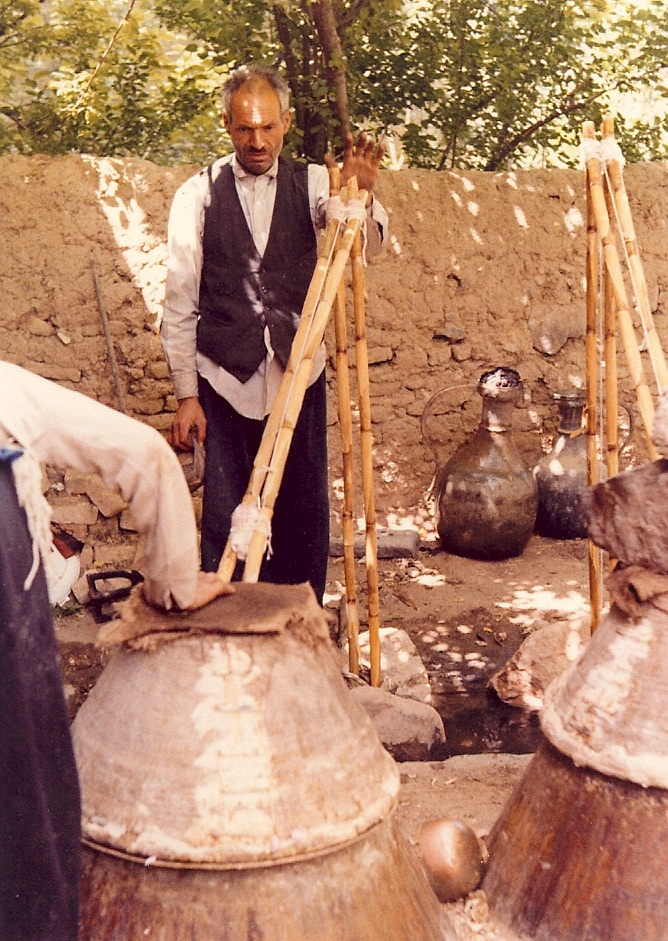[fusion_builder_container hundred_percent=”yes” overflow=”visible”][fusion_builder_row][fusion_builder_column type=”1_1″ background_position=”left top” background_color=”” border_size=”” border_color=”” border_style=”solid” spacing=”yes” background_image=”” background_repeat=”no-repeat” padding=”” margin_top=”0px” margin_bottom=”0px” class=”” id=”” animation_type=”” animation_speed=”0.3″ animation_direction=”left” hide_on_mobile=”no” center_content=”no” min_height=”none”]

For some, rose distillation in Iran has changed little in the last 1,000 years. In spite of the simple set-up, this farmer produces an excellent quality rose otto
what are they?
Essential oils are found in aromatic plants, and they contain the volatile molecules that contribute fragrance and taste. About 400-500 essential oils are commercially produced – the number varies according to how you decide to count, and what you include or exclude. There are many more aromatic plants than there are commercially produced oils. For example grapes, guavas, apples, pears, passionfruit, peaches, papayas, pineapples, cranberries, carrots, cabbage leaves, celery stalks and MANY other fruits and vegetables contain essential oils, but these are not commercially extracted.
Most essential oils that are produced on a large scale are intended for use in the fragrance or flavor industry, although this in itself does not mean that those same essential oils could not be used for therapeutic purposes. Tea tree is an example of an essential oil produced on a large scale, primarily for therapeutic use.
Many essential oils are now produced from organically grown plants, some of these on quite a large scale, for example citrus oils from South America or Italy. As citrus oils require specialized equipment for extraction, there is not much small-scale production.
A great many essential oils are not distilled in gleaming, modern facilities – for example, the rose otto being processed in the picture to the right. The quality of oil partly depends on the still, for example the metal it is made of. I know this Iranian rose otto was good, because I purchased some and had it analyzed.
the extraction process
Essential oils are extracted by distillation or expression. In steam distillation, the most commonly-used form, steam is passes upwards through the tightly packed plant material, causing the tiny “oil sacs” to rupture, releasing their contents as vapor. The essential oil/steam mix is then cooled, and as it condenses, the essential oil and water separate, usually with the oil floating on top. It is then separated and filtered. In hydro-distillation, the plant material is boiled in water, and this works better for certain plants, such as roses.
Expression is a cold, mechanical process used for citrus fruits, though distilled citrus oils are also produced, notably from limes. Several mechanical processes have been developed, a common one being a large, revolving drum with thousands of sharp spikes in the inside. The fruit is loaded into the drum, and as it turns, the spikes rupture the oil sacs, and the essential oil runs out of holes in the drum and is collected below.
A typical essential oil is a mixture of one hundred or more constituents, each one biosynthesized by the plant by means of enzymes. The oil is stored in tiny compartments, either within the plant tissue (flower, seed, wood, etc.) or in the case of some leaves such as sage, on the outside surface. In these cases, even gently rubbing the leaf causes the oil sacs to rupture.
why do plants produce essential oils?
The essential oil in a plant has two types of function: protection and communication. It affords the host plant protection from pathogenic micro-organisms such as bacteria or fungi, and/or it deters herbivorous mammals from consuming the plant. The “fragrant cloud” surrounding the plant may attract a particular species of bee, for example, that will help the plant reproduce by cross-pollination when it visits similar plants in flower. Or as with mammals, insects that would otherwise eat the plant are deterred by the slowly vaporizing essential oil.
Consequently, it is not surprising to find that certain essential oil constituents are neurotoxic to specific insects, or act as insect repellents. Because essential oils have evolved to be so effective in deterring insects, natural crop protection sprays are being commercially developed. In other cases, the essential oil may mimic insect pheromones, fooling a male insect into believing it is homing in on a female of the same species. In a few instances, plants communicate with other plants of the same species through release of essential oil, warning of predators so that plants receiving the message will increase production of anti-feedant chemicals.
Many of the same chemical constituents that are found in essential oils are also biosynthesized by insects, and function as pheromones, communicating messages such as scent trail marking, gender identification or attack alerts. For many of the above reasons, essential oil constituents need to be volatile – they need to be released as and when needed, and they need to carry their “message” across space.
the evolution of function
It is not therefore surprising to find that essential oils similarly protect humans against certain disease-causing microbes – in many cases, the same ones that can damage plants. And, it’s not too much of a stretch to believe that the interaction with an insect’s nervous system, in the course of time, evolved to include interaction with mammalian nervous systems. Many essential oils are found to be either CNS stimulants or sedatives in humans. Nature is very good at adapting, and rarely invents something new when an existing invention will suffice. Just as essential oil constituents perform multiple functions in plants and insects, so they also do in mammals. Our bodies are biologically programmed to react to essential oil constituents, which interact with a variety of receptor sites, neurochemicals and enzymes, giving them a potential for therapeutic activity.
Essential oils are an important part of the chemical soup in which all life thrives, at least on land. In small amounts, we inhale them in the ambient air, and we consume them in many fruits and vegetables. They contribute fragrance to flowers, taste to food, and medicinal properties to herbs and spices.[/fusion_builder_column][/fusion_builder_row][/fusion_builder_container]

